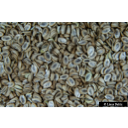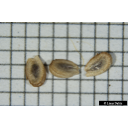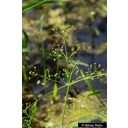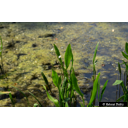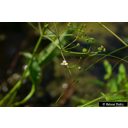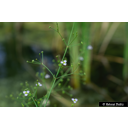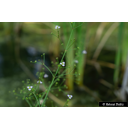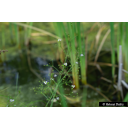Wissenswertes zum Taxon (Art, Unterart, Varietät...)
Alisma plantago-aquatica L. 1753
Alismataceae - Froschlöffelgewächse (APG IV)
Gewöhnlicher Froschlöffel
Quelle: Schmeil-Fitschen 2019
Verbreitung: Europa, Türkei, Levante, Kaukasus, Iran, West-Sibirien, Afghanistan, Pakistan, Kosmopolit
Verbreitungskarte Bundesamt für Naturschutz BfN
Blütezeit: VII - VIII
Alisma plantago-aquatica L. subsp. plantago-aquatica - Accepted: Alisma plantago-aquatica L. subsp. plantago-aquatica bei Zander 2008; Familie: Alismataceae (Zander 2008)
Alisma plantago-aquatica L. subsp. plantago-aquatica - Accepted: Alisma plantago-aquatica L. subsp. plantago-aquatica bei The Plant List (2010); Familie: Alismataceae (APG III)
Alisma plantago-aquatica L. subsp. plantago-aquatica - Accepted: Alisma plantago-aquatica L. bei The Plant List (2014), version 1.1; Familie: Alismataceae (APG III)
Alisma plantago-aquatica L. - Accepted: Alisma plantago-aquatica L. bei The Plant List (2014), version 1.1; Familie: Alismataceae (APG III)
Alisma plantago-aquatica L. - Accepted: Alisma plantago-aquatica L. bei The Plant List (2014), version 1.1; Familie: Alismataceae (APG IV)
Alisma plantago-aquatica L. - Accepted: Alisma plantago-aquatica L. bei Plants of the World Online; Familie: Alismataceae (APG IV)
Alisma plantago-aquatica L. - Accepted: Alisma plantago-aquatica L. bei Rothmaler 2011; Familie: Alismataceae (APG IV)
Alisma plantago-aquatica L. subsp. plantago-aquatica - Accepted: Alisma plantago-aquatica L. subsp. plantago-aquatica bei The Plant List (2010); Familie: Alismataceae (APG III)
Alisma plantago-aquatica L. subsp. plantago-aquatica - Accepted: Alisma plantago-aquatica L. bei The Plant List (2014), version 1.1; Familie: Alismataceae (APG III)
Alisma plantago-aquatica L. - Accepted: Alisma plantago-aquatica L. bei The Plant List (2014), version 1.1; Familie: Alismataceae (APG III)
Alisma plantago-aquatica L. - Accepted: Alisma plantago-aquatica L. bei The Plant List (2014), version 1.1; Familie: Alismataceae (APG IV)
Alisma plantago-aquatica L. - Accepted: Alisma plantago-aquatica L. bei Plants of the World Online; Familie: Alismataceae (APG IV)
Alisma plantago-aquatica L. - Accepted: Alisma plantago-aquatica L. bei Rothmaler 2011; Familie: Alismataceae (APG IV)
- Unterschiede zu verwandten Arten
- blüht nachmittags
- Blüten
- Pollen.Scheibenblumen, Staubblätter mit basalem Nektargewebe, durch Schwebfliegen bestäubt
- Blütenökologie
- Pollen-Scheibenblumen
- Lebensform
- krautig, aquatisch
- Blätter
- Heterophyllie, unterste Bläter schmal, unter Wasser lang flutend; obere Blätter breitlanzettlich, frisch giftig
- Früchte
- scheibenförmige Spaltfrüchte, in Teilfrüchte mit Schwimmgewebe zerfallend, Schwimmverbreitung, Schwimddauer über 15 Monate, auch Wasserhaftungsverbreitung durch Wasservögel
- Bodenbedingungen
- nährstoffreich
- Wurzeltypus
- Rhizom: knolliges Speicherorgan
- Natürliches Vorkommen (Habitat)
- an Gewässerufern, in Verlandungsgesellschaften
- Verwendung
- Stärkereiche Rhizome in der Westmongolei gekocht gegessen
Erhardt, W., Götz, E., Bödeker, N. & Seybold, S. (2008): Der große Zander. Enzyklopädie der Pflanzennamen. Band 2. Arten und Sorten. Eugen Ulmer KG, Stuttgart (Hohenheim), 18. Aufl., 2103 S.;
Kew Gardens and Collaborators (2017): Plants of the World Online. see: plantsoftheworldonline.org.;
The International Plant Names Index (2009). Published on the Internet http://www.ipni.org; Courtesy to IPNI, 2009. Exported from IPNI at date: 2009-09-22 20:17:51;
Kew Gardens and Collaborators (2017): Plants of the World Online. see: plantsoftheworldonline.org.;
The International Plant Names Index (2009). Published on the Internet http://www.ipni.org; Courtesy to IPNI, 2009. Exported from IPNI at date: 2009-09-22 20:17:51;
Letzte Aktualisierung:
Taxonomische Aktualisierung: Helmut Dalitz am: 21.7.2021Aktualisierung des Steckbriefs: Gliniars Robert; Helmut Dalitz; zuletzt von: Gliniars Robert am: 13.4.2022 (HOH-1105648)

